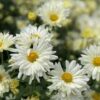**The Form and Structure of Chamomile Flowers**

**Introduction to Chamomile Flowers:**
Chamomile, with its charming and intricate blooms, has long captured the fascination of botanists, herbalists, and garden enthusiasts alike. The unique form and structure of chamomile flowers not only contribute to their aesthetic appeal but also serve essential functions in reproduction, pollination, and ecological interactions. Exploring the morphology and anatomy of chamomile flowers offers insights into the intricate biological mechanisms underlying their beauty and functionality.
**Morphological Characteristics:**
Chamomile flowers exhibit a distinctive daisy-like appearance characterized by a central disk surrounded by ray florets. Each flower head, or capitulum, consists of numerous individual florets arranged in concentric rings, creating the illusion of a single composite flower. The central disk comprises tiny tubular florets, while the surrounding ray florets possess elongated, strap-like petals radiating outward from the center. This composite inflorescence structure enhances the visibility of chamomile flowers to pollinators and facilitates efficient pollen transfer during pollination.
**Anatomy of Chamomile Flowers:**
Examining the internal anatomy of chamomile flowers reveals the intricate arrangement of reproductive organs and supporting tissues essential for sexual reproduction. Each floret consists of a tubular corolla composed of fused petals surrounding the reproductive organs, including stamens and pistils. The stamens, male reproductive structures, produce pollen grains within elongated anthers positioned atop slender filaments. The pistil, the female reproductive structure, consists of a stigma, style, and ovary containing ovules. The stigma serves as the receptive surface for pollen grains, while the style facilitates pollen tube growth and ovule fertilization. Upon fertilization, the ovules develop into seeds within the ovary, initiating the next generation of chamomile plants.
**Coloration and Pigmentation:**
Chamomile flowers exhibit a diverse range of colors and pigmentation patterns, ranging from vibrant yellows and whites to pale creams and greens. The coloration of chamomile petals is primarily attributed to the presence of pigments such as flavonoids, carotenoids, and anthocyanins, which impart distinct hues and shades to the flowers. Flavonoids, including apigenin and luteolin, contribute to the yellow coloration of chamomile petals, while carotenoids such as β-carotene and lycopene enhance the orange and red hues observed in some cultivars. Anthocyanins, though less abundant in chamomile flowers, may contribute to pink and purple color variations under certain environmental conditions.
**Structural Adaptations for Pollination:**
The form and structure of chamomile flowers are finely tuned to facilitate efficient pollination by attracting, guiding, and rewarding pollinators. The bright yellow coloration of chamomile ray florets serves as a visual attractant, drawing the attention of pollinators such as bees, butterflies, and hoverflies. The arrangement of florets within the capitulum optimizes access to nectar and pollen resources, ensuring that pollinators come into contact with reproductive organs while foraging for rewards. Additionally, the production of nectar and aromatic compounds, such as chamazulene and bisabolol, further entices pollinators and reinforces their association with chamomile flowers.
**Adaptations for Seed Dispersal:**
After fertilization, chamomile flowers undergo senescence, withering, and seed maturation, culminating in the dispersal of seeds to colonize new habitats and ensure the survival of the species. The development of seeds within the ovary is supported by nutrient reserves and protective tissues, including the ovary wall and surrounding bracts. As the seeds mature, the capitulum transforms into a seed head composed of numerous individual seeds enclosed within hardened bracts. Upon maturation, the seed head undergoes dehiscence, releasing the seeds into the surrounding environment. Seed dispersal mechanisms such as wind dispersal, animal-mediated dispersal, and human dispersal contribute to the dispersal and establishment of chamomile populations in diverse ecosystems.
**Conclusion:**
The form and structure of chamomile flowers exemplify nature’s ingenuity in crafting botanical marvels that are both aesthetically pleasing and functionally adaptive. From the intricate arrangement of florets to the vibrant colors and pigmentation patterns, chamomile flowers embody the complex interplay of genetic, physiological, and ecological factors shaping their morphology and anatomy. By delving into the fascinating world of chamomile flower morphology, we gain a deeper appreciation for the beauty, diversity, and evolutionary significance of this beloved botanical species.
**Part 2: Functional Significance and Ecological Adaptations of Chamomile Flowers**
**Functional Significance of Flower Morphology:**
The intricate form and structure of chamomile flowers serve essential functions beyond mere aesthetics, playing critical roles in reproductive success, pollinator attraction, and ecological interactions. The composite inflorescence structure, with its central disk and ray florets, enhances the visibility of chamomile flowers to pollinators, facilitating efficient pollen transfer and fertilization. The tubular shape of the corolla and arrangement of reproductive organs within each floret optimize the mechanics of pollination, ensuring the deposition of pollen grains onto receptive stigmas for successful fertilization. Furthermore, the coloration and pigmentation of chamomile petals act as visual cues to attract specific pollinator species while deterring potential herbivores, thus contributing to the plant’s reproductive fitness and survival in natural habitats.
**Adaptive Strategies for Pollination:**
Chamomile flowers have evolved a suite of adaptive strategies to maximize pollination success and ensure reproductive viability in diverse ecological settings. The production of nectar rewards within the floral structures serves as a primary incentive for pollinators, attracting them to the flowers and promoting visitation. Additionally, the temporal and spatial arrangement of florets within the capitulum optimizes pollen transfer by promoting cross-pollination between individual flowers and reducing self-pollination rates. Some chamomile species exhibit protandry or protogyny, wherein the male and female reproductive organs mature at different times, further enhancing outcrossing and genetic diversity. These adaptive mechanisms underscore the dynamic coevolutionary relationships between chamomile plants and their pollinator partners, shaping the ecological networks and biodiversity of chamomile habitats.
**Structural Adaptations for Seed Dispersal:**
Following successful fertilization, chamomile flowers undergo senescence and seed maturation, culminating in the dispersal of seeds to colonize new habitats and ensure the perpetuation of the species. The structural adaptations of chamomile flowers facilitate seed dispersal through various mechanisms, including wind dispersal, animal-mediated dispersal, and human dispersal. The lightweight and aerodynamic nature of chamomile seeds, coupled with their appendages or pappus structures, enables efficient wind dispersal over long distances, promoting the colonization of distant habitats and the establishment of new populations. Animal-mediated dispersal, facilitated by animals such as birds, mammals, and insects, further aids in seed dispersal by transporting seeds adhered to their fur, feathers, or bodies to different locations. Human activities, including cultivation, harvesting, and seed dispersal, also contribute to the dispersal and spread of chamomile seeds, shaping its distribution and abundance in anthropogenic landscapes.
**Ecological Interactions and Mutualistic Relationships:**
Chamomile flowers serve as focal points for diverse ecological interactions and mutualistic relationships with pollinators, herbivores, and other floral visitors. Pollinators such as bees, butterflies, and hoverflies rely on chamomile flowers for nectar and pollen resources, contributing to the plants’ reproductive success through pollen transfer and fertilization. In return, chamomile flowers provide pollinators with essential nutrients and energy sources, supporting their foraging behaviors and life cycles. Additionally, chamomile flowers may engage in mutualistic interactions with beneficial insects such as predatory wasps and parasitoid flies, which prey on herbivorous insects and protect chamomile plants from pest damage. These complex ecological dynamics underscore the integral role of chamomile flowers in supporting biodiversity, ecosystem functioning, and ecosystem services in natural and agricultural landscapes.
**Conclusion:**
The form and structure of chamomile flowers embody a remarkable blend of functional significance, adaptive strategies, and ecological adaptations honed through millions of years of evolutionary history. From their intricate morphology to their diverse ecological interactions, chamomile flowers epitomize the beauty and complexity of nature’s design in the plant kingdom. By unraveling the functional significance and ecological adaptations of chamomile flowers, we gain a deeper appreciation for their essential roles in supporting pollinator diversity, ecosystem resilience, and human well-being.

